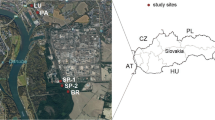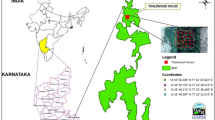Abstract
Although harvestmen (Opiliones) are among the best studied groups of arachnids in Europe from the faunistic point of view, there is still lack of available information on ecological requirements of the particular species. Habitat preferences that determine the distribution of species are largely determined by the habitat structure and microclimate. Besides other factors, these characteristics of habitats are also influenced by the nature of the vegetation. Therefore, our study dealt with the influence of tree species on harvestmen communities. We conducted the research on nine sites in the Borová hora arboretum (Zvolen town, Central Slovakia). Each studied site represents a monoculture of one of nine tree species. On each site also some attributes of soil and leaf litter (pH, conductivity, content of H, C, N and P) were evaluated. Harvestmen were collected by pitfall trapping during vegetation periods in 2008–2012. In total, 2515 individuals of 17 species and 3 families were obtained. Significant differences were revealed between the compared forest stands in terms of total epigeic activity and species richness of harvestmen. The hierarchical cluster analysis divided harvestmen communities into two main clusters (except community of the site with European hornbeam). The first one represented four sites with relatively lower canopy (< 50%) and with the higher number of captured individuals, the second cluster grouped four sites with higher canopy (> 50%) and with the lower number of captured individuals. The results of research confirmed statistically significant relationships between the litter conductivity and equitability and between the litter pH and equitability of harvestmen communities.
Similar content being viewed by others
References
Almeida-Neto M., Machado G., Pinto-da-Rocha R. & Giaretta A.A. 2006. Harvestmen (Arachnida: Opiliones) species distribution along three Neotropical elevational gradients: an alternative rescue effect to explain Rapoport’s rule? J. Biogeography 33 (2): 361–375. DOI: https://doi.org/10.1111/j.1365-2699.2005.01389.x
Atul Kumar H.P. 2015. Electrical conductivity in relation with macro-micro nutrients of agricultural soil of Amereli district. Int. J. Human. Art. Med. Sci. 3 (8): 25–30.
Avram S. 1971. Quelques speces nouvelles ou connues du genre Trogulus Latr. (Opiliones). Travaux de l’Institut de Spéologie “Émile Racovitza”, Bucharest 10: 245–272.
Begon M., Harper J.L. & Townsend C.R. 1997. Ekologie: jedinci, populace a společenstva [Ecology: individuals, populations and communities]. Vydavatelství Univerzity Palackého, Olomouc, 949 pp. ISBN: 80-7067-695-7
Čížová M. 2005. Meteorologické pozorovania v Arboréte Borová hora. In: Lukáčik I. & Škvareninová J. (eds), Autochtónna dendroflóra a jej uplatnenie v krajine, Zborník odborných a vedeckých prác, vydaný pri príležitost, 40. výročia založenia Arboréta Borová hora, TU vo Zvolene, Zvolen, CD-ROOM, 135 pp. ISBN: 80228148144, 9788022814812
Chaudhari P.R & Ahire D.V. 2013. Electrical conductivity and dielectric constant as predictors of chemical properties and available nutrients in the soil. J. Chem. Biol. Phys. Sci. 3 (2): 1382–1388.
Chemini C. 1984. Sulla presenza di Trogulus closanicus Avram in Austria, Baviera e Slovenia (Arachnida: Opiliones). Ber. Nat.-Med. Verein Innsbruck 71: 57–61.
Clarke K.R. 1993. Non-parametric multivariate analysis of changes in community structure. Austr. J. Ecol. 18 (1): 117–143. DOI: https://doi.org/10.1111/j.1442-9993.1993.tb00438.x
Delfosse E. 2004. Catalogue préliminaire des Opilions de France métropolitaine (Arachnida, Opiliones). Bull. Phyllie 20: 34–58.
Dufręne M. & Legendre P. 1997. Species assemblages and indicator species: the need for a flexible asymmetrical approach. Ecol. Monogr. 67 (3): 345–366. DOI: https://doi.org/10.1890/0012-9615(1997)067[0345:SAAIST]2.0.CO;2
Dunger W. 1958. Über die der Zersetzung Laubstreu durch die Boden-Makrofauna im Auenwald. Zool. Jahrb. Abt. Syst. Ökol. Geogr. Tiere 86: 139–180.
Edgar A.L. 1971. Studies on the Biology and Ecology of Michigan Phalangida (Opiliones). Miscellaneous Publications (University of Michigan. Museum of Zoology) 144, 64 pp.
Goslee S.C. & Urban D.L. 2007. The ecodist package for dissimilarity-based analysis of ecological data. J. Statist. Softw. 22 (7): 1–19. DOI: https://doi.org/10.18637/jss.v022.i07
Gruber J. 1985. Über Opilio canestrinii (Thorell) und Opilio transversalis Roewer (Arachnida: Opiliones, Phalangiidae). Ann. Naturhist. Mus. Wien 86 B: 251–273.
Gruber J. 1988. Neunachweise und Ergänzungen zur Verbreitung von Opilio canestrinii (Thorell) und Opilio transversalis Roewer. Ann. Naturhist. Mus. Wien 90 B: 361–365.
Klimeš L. 1999. Přehlížení synantropní sekáči (Opiliones): novinky z česko-slovenského pomezí i odjinud [Neglected synanthropic harvestmen (Opiliones): novelties from the Czech-Slovak borderland and other areas]. Sbornik Přírodovědeckeho Klubu Uherské Hradiště 4: 68–71.
Komposch C. 1993. Neue synanthrope Arachniden für Kärnten und die Steiermark (Arachnida: Opiliones, Araneae). Carinthia II 183 (103): 803–814.
Labanc J. & Čížová M. 1993. Arborétum Borová hora Technickej univerzity vo Zvolene. Technická univerzita vo Zvolene, 34 pp.
Lukáčik I., Čížová M., Ježovič V. & Škvareninová J. 2005. Arborétum Borová hora 1965–2005. Technická univerzita vo Zvolene, 91 pp. ISBN:80-228-1479-2
Mantel N. 1967. The detection of disease clustering and a generalized regression approach. Cancer Res. 27 (2 Part 1): 209–220. PMID: 6018555
Maršalek P. 1999. Niekoľko poznámok k faune koscov (Opilionida) Slanských vrchov. Natura Carpatica 40: 225–230.
Maršalek P. 2004. Opiliofauna Volovských vrchov. Natura Carpatica 45: 117–124.
Maršalek P. & Stašiov S. 2015. Kosce (Arachnida, Opiliones) pohoria Čergov. Folia Faun. Slov. 20 (2): 131–134.
Martens J. 1978. Spinnentiere, Arachnida: Weberknechte, Opiliones. Die Tierwelt Deutschlands. 64. VEB Gustav Fischer Verlag, Jena, 464 pp.
Merino-Sáinz I. & Anadón A. 2015. Local distribution patterns of harvestmen (Arachnida: Opiliones) in a Northern Temperate Biosphere Reserve landscape: influence of orientation and soil richness. Belg. J. Zool. 144 (1): 3–16.
Mihál I. 2005. Kosce (Opiliones) Národného parku Muránska planina. Reussia 2 (1): 7–14.
Mihál I. & Mašán P. 2006. Príspevok k poznaniu koscov (Opiliones) stredného a východného Slovenska. Natura Carpatica 47: 89–96.
Oksanen J., Blanchet F.G., Kindt R., Legendre P., Minchin P.R., O’Hara R.B., Simpson G.L., Solymos P., Stevens M.H.H. & Wagner H. 2015. Vegan: Community Ecology Package. R package version 2.3-1. https://doi.org/CRAN.Rproject.org/package=vegan.
Pagan J., Čížová M., Greštiak M., Labanc J., Obr F., Petrík M. & Višňovská V. 1975. Arborétum Borová hora 1965–1975. VŠLD vo Zvolene, 319 pp.
Pinto-da-Rocha R., Machado G. & Gibert G. 2007. Hatvestmen: The Biology of Opiliones. Harvard Univ. Press, Cambridge, Massachusetts, London, 608 pp. ISBN-13: 978-0674023437
Proud D.N., Tibbetts J.A., Moore M.K. & Townsend V.R.Jr. 2011. Diversity of Neotropical harvestmen (Arachnida: Opiliones) inhabiting logs and palm fronds in the rain forests of Trinidad. Ann. Entomol. Soc. Amer. 104 (2): 241–248. DOI: https://doi.org/10.1603/AN10077
Rahmani R. & Mayvan H.Z. 2003. Diversity and assemblage structure of soil invertebrates in beech, hornbeam and oakhornbeam forest types. Iran. J. Nat. Resour. 56 (4): 425–436.
R Core Tea. 2015. R: A Language and Environment for Statistical Computing. R Foundation for Statistical Computing, Vienna, Austria. https://doi.org/www.R-project.org/
Roberts W.D. 2015. labdsv: Ordination and Multivariate Analysis for Ecology. R package version 1.7-0. https://doi.org/CRAN.Rproject.org.
Rozwalka R. & Staręga W. 2012. The invasive harvestman Opilio canestrinii (Thorell, 1876) (Opiliones: Phalangiidae) in Poland. Fragm. Faun. 55 (2): 161–168.
ai]Shannon C.E. 1948. A mathematical theory of communication. Bell System Technical Journal 27 (3): 379–423 DOI: https://doi.org/10.1002/j.1538-7305.1948.tb01338.x. 27 (4): 623–656. DOI: https://doi.org/10.1002/j.1538-7305.1948.tb00917.x
Stašiov S. 2000. Opiliofauna Ondavskej vrchoviny. Natura Carpatica 41: 39–43.
Stašiov S. 2001. Vybrané skupiny epigeickej makrofauny (Opilionida, Diplopoda a Chilopoda) ako indikátory stavu vrchnej pôdnej vrstvy v podhorskej bučine. Vedecké štúdie. Technická univerzita vo Zvolene, Zvolen, 88 pp. ISBN: 80-228-1111-4
Stašiov S. 2004. Kosce (Opiliones) Slovenska. Vedecké štúdie, 3/2004/A. Technická univerzita vo Zvolene, Zvolen, 118 pp. ISBN: 80-228-1318-4
Stašiov S. 2009. Millipede (Diplopoda) communities in mixed oak-hornbeam forest stands–effect of selected site factors. Pol. J. Ecol. 57 (4): 785–792.
Stašiov S. 2015. Ekológia pôdnych organizmov (pôdne živočíchy). Vysokoškolská učebnica. Technická univerzita vo Zvolene, 150 pp. ISBN: 978-80-228-2830-7
Stašiov S., Bitušík P. & Šamaj J. 1997. Kosce (Opiliones) NPR Malý Polom (CHKO Kysuce). Ochrana prírody, Banská Bystrica 15: 119–125.
Stašiov S., Hazuchová L. & Mihál I. 2010. Harvestmen (Opiliones) of Zvolen. Sekáči (Opiliones) Zvolena. Acta Rer. Nat. 8: 37–41.
Stašiov S., Maršalek P., Mihál I., Mašán P., Astaloš B. & Jarab M. 2003. Kosce (Opiliones) Ondavskej vrchoviny. Natura Carpatica 44: 261–266.
Sudduth K.A., Drummond S.T. & Kitchen N.R. 2001. Accuracy issues in electromagnetic induction sensing of soil electrical conductivity for precision agriculture. Computers and Electronics in Agriculture 31 (3): 239–264. DOI: https://doi.org/10.1016/S0168-1699(00)00185-X
Wallwork J.A. 1970. Ecology of Soil Animals. (European Animal Biology Series). McGraw-Hill, London, 283 pp. ISBN-10: 0070941246
Author information
Authors and Affiliations
Corresponding author
Rights and permissions
About this article
Cite this article
Stašiov, S., Michalková, E., Lukáčik, I. et al. Harvestmen (Opiliones) communities in an arboretum: Influence of tree species. Biologia 72, 184–193 (2017). https://doi.org/10.1515/biolog-2017-0021
Received:
Accepted:
Published:
Issue Date:
DOI: https://doi.org/10.1515/biolog-2017-0021




